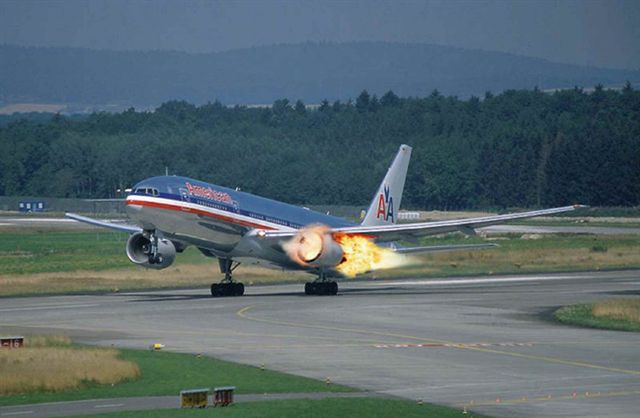Update: Fake! The original photo is here, along with a discussion of most of the same concerns about fakery. Again, reader Jim is the source (Jim needs a blog). Thanks, Jim!
This has been floating around the internet for a bit, and I finally got a copy forwarded to me. I think it’s a full-on engine fire, but it could be a compressor stall. Either way, what a picture!



(yikes) I am *so* glad that I was not on that plane.
New Engine and new underwear for passengers.
Note the jet flame at the far rear and near forward of the engine. Its a full-on engine fire and an attempt at an early reverse thrust upon landing.
Umm, was it photoshopped? I mean, there is no smoke which not possible unless this is a flash fire from an explosion just at touch down.
And there are no reflections of the fire in the reflective underside of the aircraft.
I’m not against the idea that this was photoshopped, but have no info either way. It came to me as one of those ‘mass forwarded’ things, “cool picture”.
I’d say it’s a fake. The real photo is a 777 doing a flaps-up landing, which is an emergency situation even without a fire. The reflection on the side of the fuselage shows the ground shadow and a small part of the engine nacelle. There is no fire in the reflection. The flaming engine was probably pasted from another photo because its orientation is about 5 degrees nose up relative to the starboard engine, the paint color is slightly different, and the nacelle shape is slightly different.
The odd thing about this photo is that it shows the wing deflected up considerably, indicating a large lift force, but the main gear are squarely on the ground. That could be a simple consequence of the timing of the photo, though. A flaps-up landing would load the outboard region of the wing much more than a normal landing.
Why is it not a takeoff? That was my explanation for the large upward wing deflection.
Man, you guys are so cool, good thing you raised the issue it might be faked before CBS got a hold of it.
Seriously though, to me even the flames look like they’ve been mixed as well.
The cone of flame out the rear looks more like a focused and properly function afterburner than a low pressure, widely dispersed ?engine event.?
Experimenting with JATO on civilian aircraft. Two-armed (winged) study, right wing controlled.
Nice one, Dr. Henry, very good.